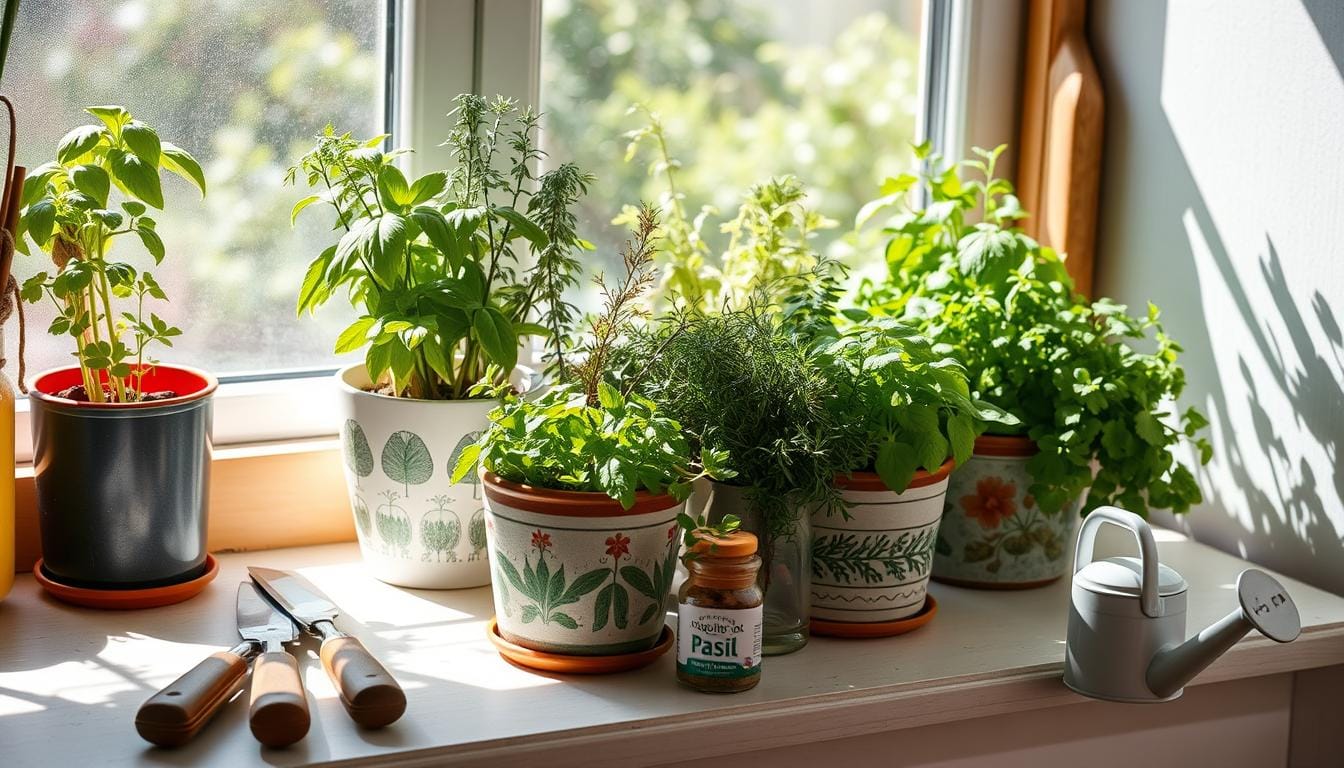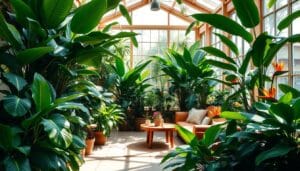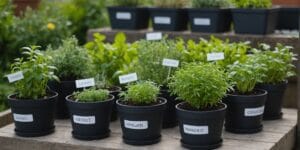Imagine having a lush, thriving herb garden right at your fingertips, just steps away in your own kitchen. Growing indoor herbs is a wonderful way to add fresh, fragrant flavor to your culinary creations. It also brings the benefits of a sustainable, self-sufficient lifestyle. Whether you’re a seasoned home cook or a novice in the kitchen, indoor herbs can transform your cooking experience.
From the aromatic basil to the versatile rosemary, a diverse collection of indoor herbs can provide you with a wealth of culinary possibilities. These plants add vibrant color and enticing scents to your kitchen. They also offer a convenient and cost-effective alternative to purchasing costly, often air-flown herbs from the grocery store. With the right conditions and a little bit of care, you can enjoy a bountiful harvest of fresh herbs year-round, right from the comfort of your own home.
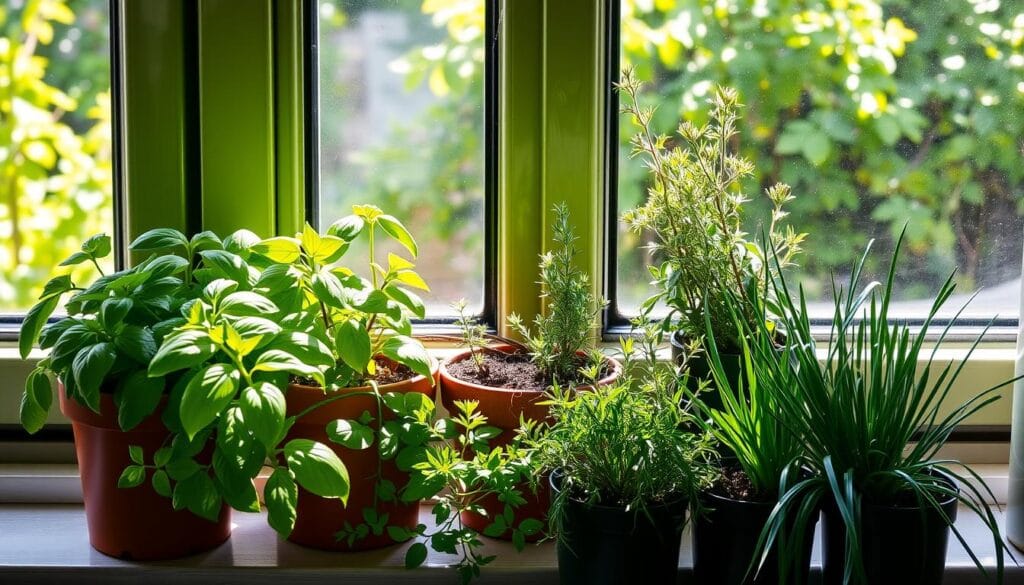
Whether you have a large kitchen with ample window space or a cozy nook with limited square footage, there are a variety of indoor herb options that can thrive in your unique environment. From space-saving vertical gardens to compact countertop planters, the possibilities are endless when it comes to integrating these culinary wonders into your kitchen decor.
The Benefits of Growing Your Own Kitchen Herb Garden
Having an indoor herb garden in your kitchen brings many benefits. It’s not just about having fresh herbs for cooking. It also saves money, improves your health, and helps the environment.
Cost Savings and Fresh Flavors Year-Round
Growing herbs indoors means you always have fresh herbs. You won’t need to buy expensive ones from the store. This saves money and makes your food taste better.
Health Benefits of Fresh Herbs
Fresh herbs are good for you. They’re full of antioxidants, vitamins, and minerals. Growing your own herb gardening tips means your herbs are pesticide-free. This makes them healthier for you.
Environmental Impact and Sustainability
Growing herbs indoors is better for the planet. It cuts down on waste and emissions from store-bought herbs. It’s a step towards a greener lifestyle.
“Growing your own herbs is a simple and rewarding way to reduce your environmental footprint while enjoying the freshest, most flavorful ingredients possible.”
Essential Requirements for Indoor Herb Success
Growing an indoor herb garden is rewarding and adds flavor to your kitchen. But, it needs careful attention to succeed. You must provide the right light and maintain the soil’s condition.
Light Needs
Most herbs need bright, direct sunlight for at least 6 hours a day. Place your garden near a south-facing window or use a grow light. This ensures your plants get enough light.
Temperature and Humidity
Herbs like temperatures between 65-75°F and moderate humidity. Don’t put your garden in drafty spots or near heat. Changes in temperature and humidity can harm your plants.
Soil and Drainage
- Use well-draining, nutrient-rich potting soil for indoor herbs.
- Don’t use garden soil, as it’s too dense for containers.
- Make sure pots have drainage holes to prevent waterlogging.
Proper watering is key for indoor herb success. Keep the soil moist but not waterlogged. Don’t let the roots sit in water.
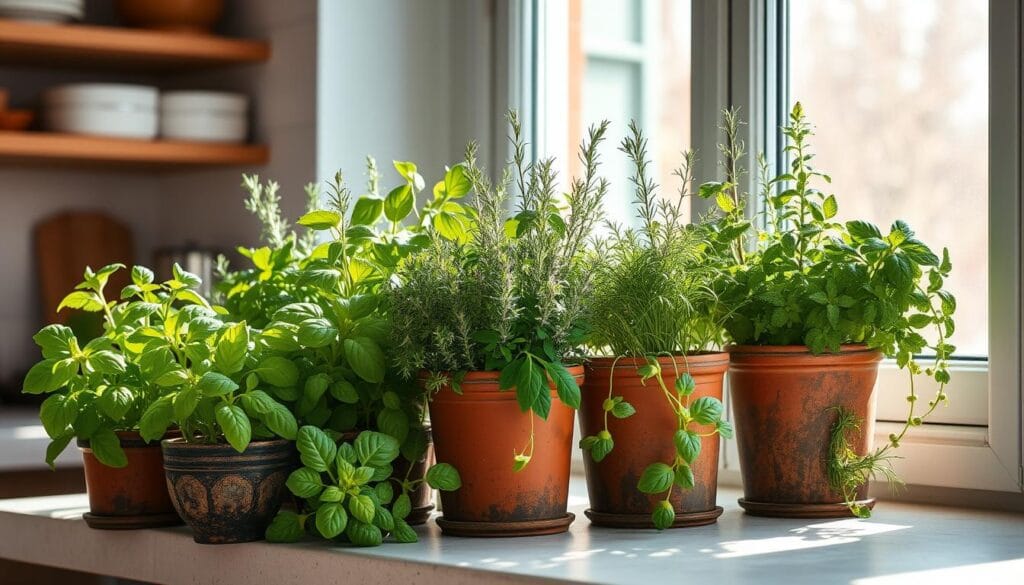
By understanding and meeting these requirements, you can enjoy a thriving indoor herb garden. Harvest fresh flavors right in your kitchen.
Top Indoor Herbs Ideas for Your Kitchen Space
Turning your kitchen into a lush indoor herb garden is rewarding and useful. It’s great for both newbies and seasoned gardeners. There are many herbs that grow well in small spaces and offer fresh flavors all year. Let’s look at the best herbs to grow inside, clever herb mixes, and how to garden indoors all year.
Best Herbs for Beginners
For those new to small space herb gardening, start with these easy indoor herbs. They’re tough, easy to care for, and add great flavor:
- Basil – It’s fragrant and versatile, making it a top choice for indoor gardens.
- Mint – It’s refreshing and grows a lot, perfect for beginners.
- Chives – These herbs add a nice onion flavor and color to dishes.
- Parsley – A classic herb that’s full of nutrients and does well in pots.
Space-Saving Herb Combinations
If you have little space, try these space-saving herb combinations. They’re great for small kitchens:
- Rosemary, thyme, and oregano – A Mediterranean mix that tastes great together.
- Cilantro, dill, and parsley – Perfect for making fresh salsas and salads.
- Sage, marjoram, and lavender – A blend that adds a rich aroma to dishes.
Year-Round Growing Options
With the right care, you can have easy indoor herbs all year. Some top choices include:
- Microgreens – They’re packed with nutrients, grow fast, and can be picked in weeks.
- Lemongrass – It adds a bright citrus flavor to soups, teas, and marinades.
- Bay leaves – Essential for stews and braises, these leaves are fragrant and flavorful.
By choosing these best herbs to grow inside, you can make a lively, useful indoor herb garden. It will make your cooking better and bring fresh tastes right to your kitchen.
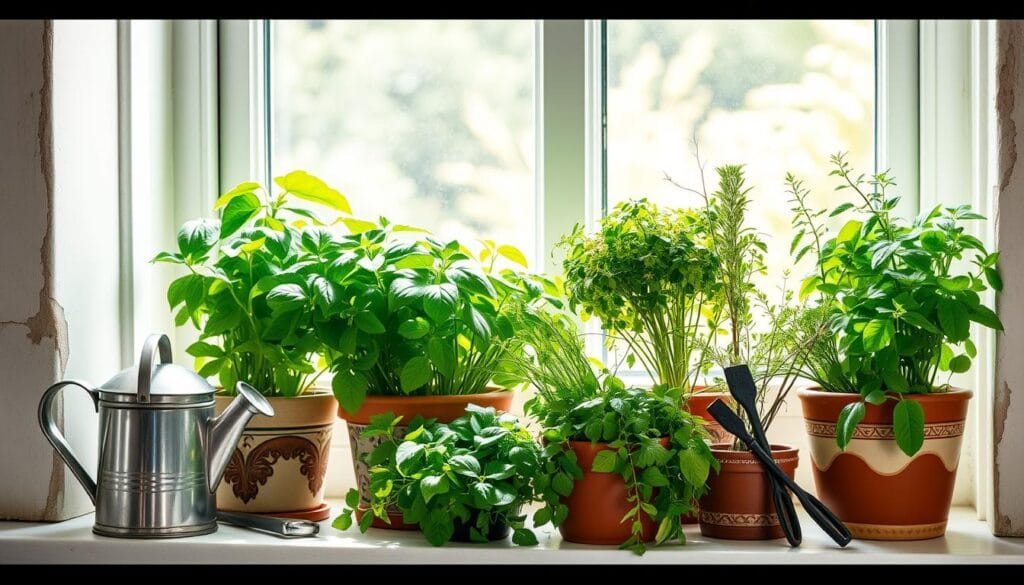
Choosing the Perfect Location: Light and Temperature
When growing windowsill herbs, low-light herbs, and other indoor herbs ideas, picking the right spot is key. Herbs need different amounts of light and temperature to grow well. Knowing what they need helps your indoor herb garden flourish.
Most herbs love bright, direct sunlight, needing at least 6 hours a day. A south-facing windowsill is perfect for this. If your kitchen isn’t sunny enough, supplemental grow lights can help.
Temperature matters too. Herbs do best in cooler spots, between 65-75°F (18-24°C). Keep them away from cold drafts and vents. A steady, moderate temperature makes your herbs happy and healthy.
| Herb | Light Requirement | Temperature Preference |
|---|---|---|
| Basil | Full sun | 65-85°F (18-29°C) |
| Thyme | Full sun to partial shade | 60-70°F (15-21°C) |
| Mint | Partial shade to full sun | 60-70°F (15-21°C) |
| Rosemary | Full sun | 65-75°F (18-24°C) |
By knowing the light and temperature needs of your indoor herbs, you can create the best conditions. This will make your kitchen herb garden thrive and produce lots of herbs.

Container Selection and Potting Solutions
Choosing the right containers and potting mix is key for a successful indoor herb garden. Whether you’re using herb garden kits or repurposing items, knowing what herbs need is important. This helps your windowsill or indoor garden flourish.
Best Containers for Different Herbs
Not all herbs need the same container. Some like shallow, wide pots, while others prefer deeper, narrower ones. Think about how big your herbs will get and pick the right size:
- Basil, chives, and parsley do well in 6-8 inch pots.
- Rosemary, thyme, and oregano need 8-10 inch pots because of their big roots.
- Mint is quite aggressive, so it’s best in its own pot to keep it from spreading.
Drainage and Soil Requirements
Good drainage is vital for indoor herbs. Pick containers with holes in the bottom. Use a potting mix made for herbs or veggies. Don’t use regular garden soil, as it can get too wet and compacted in pots.
Creative Upcycling Ideas
Want to save money or add a personal touch? Try using old items as planters. Mason jars, tin cans, and even old teacups can be great for herbs. Just remember to drill holes for drainage and use the right potting mix.
By picking the right containers, ensuring good drainage, and getting creative, you can make a vibrant indoor herb garden. It will give you fresh flavors all year.

Watering and Feeding Your Indoor Herbs
Creating a thriving indoor herb garden needs careful attention to watering and feeding. Whether you’re new or experienced in herb gardening, learning these key skills can unlock your herbs’ full potential. This is especially true for indoor culinary herbs.
Watering Your Indoor Herbs
The amount of water your herbs need depends on the plant type, container size, and your home’s environment. Generally, growing herbs indoors requires consistent moisture. But, be careful not to overwater, as it can cause root rot and other problems.
- Check the soil regularly and water when the top inch or two feels dry to the touch.
- Use lukewarm water to mimic the natural temperature of rainwater.
- Water thoroughly, ensuring the entire soil volume is evenly moistened.
- Avoid letting your herbs sit in standing water, as this can lead to root problems.
Feeding and Nutrient Requirements
Indoor herbs need a steady supply of nutrients to grow well and taste great. Start with a balanced, slow-release organic fertilizer in the soil when planting. Then, add a diluted liquid feed every few weeks to keep your herbs growing strong and flavorful.
| Nutrient | Benefits for Indoor Herbs |
|---|---|
| Nitrogen (N) | Promotes lush, green foliage growth. |
| Phosphorus (P) | Enhances root development and overall plant vigor. |
| Potassium (K) | Supports healthy plant structure and stress resistance. |
By learning how to water and feed your indoor herb garden, you’ll soon enjoy a constant supply of fresh, tasty herbs all year.
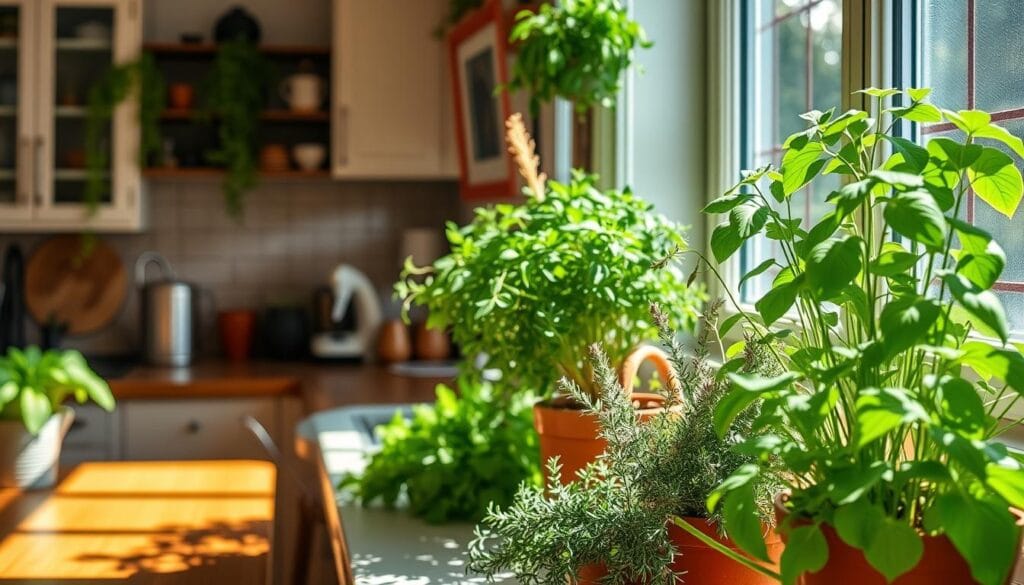
Common Problems and Troubleshooting Tips
Growing herb gardening indoors is rewarding but comes with challenges. As you start your indoor herbs ideas journey, be ready for potential issues. This section offers practical herb gardening tips to help your indoor herb plants thrive.
Pest Management
Pests like aphids, spider mites, and fungus gnats can harm your herbs. Use natural pest control methods. Try introducing beneficial insects, essential oils, or regularly check your plants for pests.
Disease Prevention
Indoor herbs face diseases like root rot, powdery mildew, and leaf spot. Prevent these by watering right, ensuring good air flow, and keeping soil conditions optimal. Watch your plants closely and fix problems quickly to keep them healthy.
Growth Issues and Solutions
- Stunted growth: Make sure your herbs get enough light, water, and nutrients.
- Yellowing leaves: This might mean your plants need more nutrients or less water. Adjust your care routine.
- Leggy plants: If your herbs are too tall, they might not get enough light. Move them to a brighter spot or add artificial light.
By tackling these common problems and using the right troubleshooting tips, you can enjoy a successful indoor herb gardening experience. You’ll have fresh, flavorful herbs all year.

Harvesting and Using Your Indoor Herbs
Growing an indoor kitchen herb garden is very rewarding. The best part is using those fresh, tasty indoor culinary herbs in your cooking. Learning how to harvest them right is important for their growth and to have plenty all year.
When you harvest, cut the leaves or stems just above new growth. This helps the plant grow more and give you more to harvest. It’s best to pick in the morning when the herbs are most flavorful. Don’t take more than one-third of the plant at once.
- Gently pinch or snip leaves and stems, leaving at least 2-3 inches of growth on the plant.
- Harvest the outer, older leaves first to promote new growth from the center.
- Use sharp, clean scissors or pruners to avoid damaging the plant.
After you pick your herbs, you can use them in many dishes. Add them to pasta sauces, salads, baked goods, and even cocktails. If you have too much, dry or freeze it to enjoy your indoor herb garden all year.
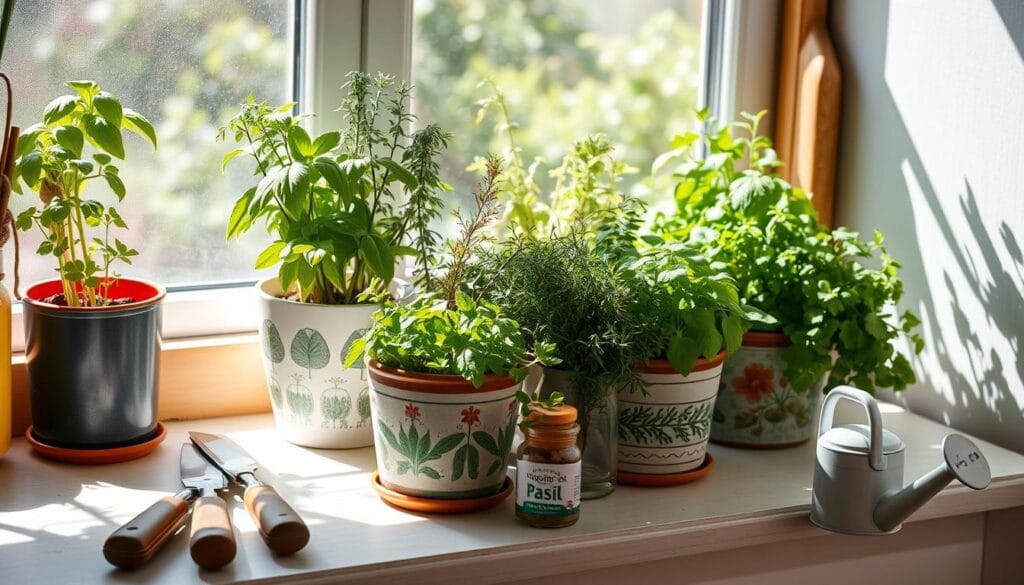
With a bit of care, your indoor herb garden will always have flavor and nutrition for your meals. Enjoy the process of harvesting and using your indoor herbs ideas to make tasty, healthy dishes that are good for you and your soul.
Conclusion
Growing an indoor herb garden is rewarding and practical for home cooks. It requires understanding the basics like lighting, temperature, and how to water. This way, you can have fresh herbs all year in your kitchen.
Starting an indoor herb garden is great for anyone, whether you’re new to gardening or experienced. It saves money, adds flavor, and boosts health. Plus, it’s good for the planet. So, why not start your own indoor herb garden today?
With the right methods and effort, you’ll enjoy harvesting your own indoor herbs ideas, growing herbs indoors, and keeping a lively indoor herb garden. Let nature’s power bring fresh, tasty possibilities into your kitchen.
FAQ
What are the benefits of growing an indoor herb garden?
Growing your own indoor herbs saves money and gives you fresh flavors all year. It’s good for your health and the planet. You’ll always have herbs ready to use, cutting down on waste and emissions.
What are the essential requirements for successful indoor herb cultivation?
For indoor herbs to thrive, they need enough light, the right water, and good soil. The temperature must be just right. With the right tools and care, your herbs will flourish.
What are the best herbs to grow indoors?
Top picks for indoor herbs include basil, mint, rosemary, thyme, chives, and parsley. They’re easy to grow and don’t need much space. Pick herbs based on your cooking style, light, and space.
How do I choose the right location for my indoor herb garden?
Choose a spot based on your herbs’ light needs. Sun-loving herbs like rosemary go in sunny windows or under grow lights. Mint and parsley do well in partial shade. Think about the temperature and air too.
What type of containers and soil are best for indoor herbs?
Herbs love containers that drain well, like ceramic pots or windowsill planters. Make sure they have holes to avoid waterlogged soil. Use a good potting mix or mix your own with compost and perlite.
How do I properly water and fertilize my indoor herbs?
Water your herbs when the soil feels dry. Don’t overwater. Use a gentle mist or water from the bottom. Fertilize with a balanced fertilizer every few weeks to keep them healthy and flavorful.
How do I harvest and use my indoor herbs?
Harvesting your herbs regularly helps them grow more. Cut off leaves or stems, leaving some growth. Use them fresh or preserve them by drying, freezing, or making oils and vinegars.
How can I troubleshoot common problems with my indoor herbs?
Watch out for pests, diseases, and growth issues. Treat problems with organic solutions. Adjusting light, temperature, and water can also help.


